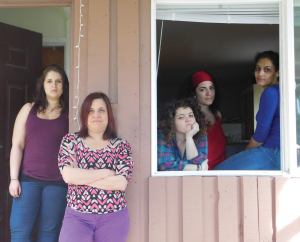
It’s Marisela’s quinceañera and the women of Bernie’s Apt. are catering the party. There are tortillas to flip, carnitas to season, and taquitos to fry. Bernie’s foster daughters frantically prepare the colossal meal for their upstairs neighbor in a small kitchen—bustling around a fridge yellowing with age, arranging food on a wooden table surrounded by mismatched chairs—while their mother Bernie, aloof to the chaos in the kitchen, perfects the song and dance routine she’ll perform for the crowd.
It’s the opening scene of ACTLab’s Bernie’s Apt., the chaos and liveliness of which are telling of the story that unfolds. We meet Maggie (Sophie Franco), a psychic medium who “siempre esta presente.” We meet Marti (Pilar O’Connell), the primary cook and caretaker of her sisters; Adela (Meme Garcia), the newest member of the family to arrive from Honduras; Angie (Javonna Arriaga), Bernie’s treasured and withdrawn biological daughter; and finally Mama Grande (Yolanda Suarez), the abuela whose brooding presence dominates her nietas on the rare occasion she emerges from her room.
On this Monday evening, the actors, director, and members of the eSe Teatro creative team are beginning the first full run-through of Rose Cano’s world premiere adaptation. Inspired by Lorca’s 1945 play The House of Bernarda Alba, Cano’s adaptation pays homage to the original, but reimagines the story in a contemporary context.
“I thought, what would that be like? What would confine these women here in Seattle?” Cano says. “I thought about what keeps a woman confined either physically, emotionally, or socially, and that’s what I wanted to explore.”
Instead of being confined by the strict social conduct of 1900s Andalusia, the women of Bernie’s Apt. are confined by house arrest, physical ailments, cultural oppression, and a system stacked against them. Bernie hosts four foster daughters to stay afloat, creating a melting pot of Latin American cultures—Bernie’s daughters are Peruvian, Mexican, Salvadorean, and Honduran—each with their own stories of finding home in the United States.

“I just thought it was the right time to be able to put six Latina women on stage,” Cano says. “They’re all the colors of the rainbow, and each one has their unique perspective. There’s not just one type of immigrant … we don’t see that enough on TV or on stage.”
Beyond the creative team table in ACT’s Lalie—littered with sugary snacks and caffeinated drinks to fuel the evening—the stage is marked with neon pink tape, enclosing Burton Yuen’s set, inspired by Seattle’s Yesler Terrace. The stage manager shows off the latest additions to the props: an empty coffeemaker and a sharp red knife set, colorful woven bowls and real tortillas. Vibrant blue and pink paper flowers are revealed for a scene in Act II, eliciting a resounding, “Ay, que lindo!” from the cast, admiring the flowers’ delicate construction.
“Our goal is to keep the forward motion,” Director Julie Beckman says, as she welcomes the cast and prepares them for the run-through.
“Julie’s really great about letting everyone bring their own baggage,” Cano says. “Your baggage is your gift from life, the accumulation of who you are … It was really nice that [the actors] could share their own stories … Everywhere from costume ideas, line suggestions, blocking ideas, food. We had so many discussions about food!”
Much of the action in Bernie’s Apt. revolves around food: the preparation of it, the lack of it, the failure of the buñuelos to rise, or the success of the tortillas to warm at the perfect temperature.
“We really pass down our stories through food—through physically touching it,” Cano says. “And we pass down our culture, our beliefs, somewhat superstitious or not, through that.”

Cano credits a 2012 conversation with Kurt Beattie, ACT’s Artistic Director Emeritus, with planting the seed of writing an adaptation, as they both explored retelling classic stories in new ways.
“He really put a spark in me,” she says.
After a 2014 workshop and a series of adaptations of other Spanish-language stories, including Don Quixote and La Celestina, Cano sought to write a play that loosely drew from real-life stories of people she encountered over her 21-year career as a Spanish translator for Harborview Medical Center.
“Every day I feel reaffirmed that they’re important stories to tell,” Cano says.
The script is also peppered with stories from her own upbringing in Peru.
“I identify with the grandma in the play,” she says. “We lived with our grandma until I was 18. She was 91, so there’s a little of my abuelita in [the story]. I think as you get older, you cling to the things that are most important to you. Even if you lose a sense of time and place, you carry that with you. I remember my grandma’s room … even the way it smelled, her santos. There’s always someone in our families that holds that tradition.”
A focal point of Yuen’s apartment set is the small ofrenda, or altar, which features the Virgin of Guadalupe in a black gilded frame.
“We’re totally in a world, and it’s comfortable,” Cano says. “Even when it’s all chaotic, it’s still comfortable. We had tamales at rehearsal and during tech, tamales and lentejas … it’s nice. Hey, we can be our own selves in the mainstream.”
Catch Bernie’s Apt. at ACT Theatre from May 5–28, 2016. For tickets and more information, visit acttheatre.org.

may have a hit on our hands. rose has written a response to Bernada’s first House that Lorca built. Now Rose and company have built their own apartment, it rocks with warm hilarity deep roots conflict and pain. Maria and I both loved it, and we are hard sells. I want to go to dinner at Bernie’s apartment.